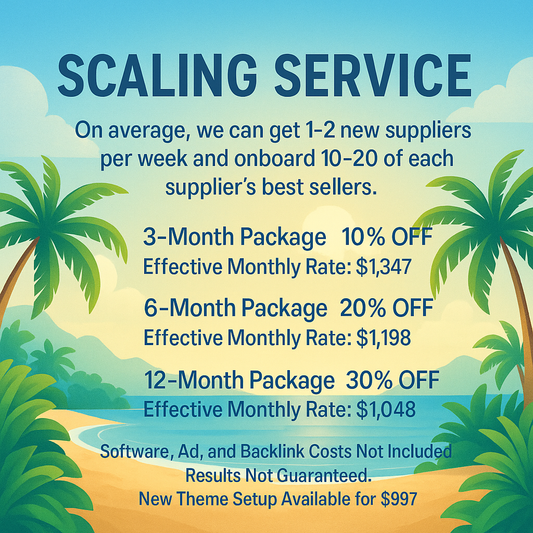
Boost Your Sales with Analytics: A Practical Guide
Welcome to the world of eCommerce! As the founder of eCommerce Paradise, I’m excited to dive into a vital topic for every entrepreneur – utilizing analytics to improve sales performance. If you're running a high-ticket dropshipping store, understanding your analytics can make the difference between mediocre sales and outstanding revenue generation. In this article, we'll cover how to harness data effectively, optimize your strategies, and ultimately scale your business. Let’s get started!
Understanding the Importance of Analytics
Analytics is more than just a buzzword; it's the heartbeat of your eCommerce operations. For those of you in the dropshipping high ticket niche, detailed analytics can lead to a profound understanding of your customers, their behaviors, and preferences.
Why You Can’t Ignore Analytics
Ignoring analytics is like sailing without a compass. It can lead you to drift aimlessly, wasting time and resources. Here’s why you need to prioritize analytics:
- Data-Driven Decisions: Relying on gut feelings can be a costly gamble. Analytics gives you empirical data to base your decisions on.
- Identifying Trends: Understanding purchasing patterns helps you stay ahead of the market curve and optimize it.
- Personalize Customer Experience: Analyze how different segments interact with your store, tailoring their experiences leads to higher engagement.
- Optimize Marketing Efforts: Knowing which channels convert best allows you to allocate budgets more efficiently.
Getting Started with Analytics Tools
To truly make analytics work for you, it is essential to use the right tools. Here’s a breakdown of some effective analytics tools that can significantly enhance your sales performance:
Google Analytics
Google Analytics is a powerhouse that offers a wealth of information regarding your site's performance. It’s free and packed with features. Here’s what it can do for your high-ticket dropshipping store:
- Track Traffic Sources: Understand where your visitors are coming from, whether that’s organic search, social media, or referrals.
- User Behavior: Analyze how users interact with your site, including pages visited, time spent on page, and bounce rates.
- Conversion Tracking: Set goals and track the completion of sales activities to see which areas of your funnel may need improvement.
Hotjar
Hotjar provides visual insights into user behavior with heatmaps and session recordings. This tool lets you observe how users interact with your site and can be particularly useful for a dropshipping high ticket business where user experience (UX) is crucial.
- Heatmaps: See where users click the most and which areas of your site they ignore.
- Session Recordings: Record user sessions to identify potential friction points in the customer journey.
- Surveys and Feedback: Gather direct feedback from users to understand their needs and challenges better.
Key Metrics You Should Track
Tracking metrics is essential for performance improvement. Here are the key metrics you should monitor closely:
Conversion Rate
Your conversion rate refers to how many visitors end up making a purchase. For a high-ticket dropshipping store, even a slight improvement can lead to significant revenue increases. Always aim to optimize the conversion rates through A/B testing and landing page optimizations.
Average Order Value (AOV)
AOV is a critical metric, particularly for dropshipping high ticket products. To increase AOV, consider implementing upselling and cross-selling techniques. For example, when a customer adds a product to their cart, suggest complementary items or premium versions of that product.
Cart Abandonment Rate
Cart abandonment is an unfortunate reality in eCommerce. Understanding when and why customers abandon their carts is vital. Use Google Analytics to track this metric, and consider sending follow-up emails to encourage them to complete their purchase.
Implementing Changes Based on Analytics
Tracking metrics without action is like having a treasure map but never searching for the treasure. Here’s how to take actionable steps:

A/B Testing
Engage in A/B testing to compare different versions of your site elements. This could include product descriptions, images, or even entire page layouts. Analyze which version drives better results, and continue iterating based on findings to optimize the customer experience.
Refining Targeting Strategies
Utilize the data collected to refine your audience targeting. For example, if analytics suggest a particular demographic responds well to your marketing materials, invest more time and resources honing in on that audience. This ensures that your marketing efforts are not only effective but also efficient.
Enhancing Your Product Offerings
Based on your sales data and user behavior analysis, consider which products are performing well and which are not. This data should guide your inventory decisions, helping you focus on high-performing items while phasing out those that underperform.
Utilizing Customer Feedback
Analyzing customer feedback is crucial for continuous improvement. Here’s how to harness this feedback into actionable insights:
Surveys and Feedback Forms
Solicit feedback directly from your customers post-purchase. This can provide insights into their shopping experience, product satisfaction, and identify potential areas for improvement. Implementing changes based on your customers’ feedback shows that you care and can significantly improve customer retention.
Online Reviews
Online reviews are a goldmine for understanding your product’s performance and service quality. Analyze the reviews for common themes, both positive and negative, and use that information to strengthen your offerings and address weaknesses.
Embracing Change and Continuing Growth
Adapting to new insights is an ongoing process. The world of eCommerce is ever-evolving, and staying ahead of the competition requires constant experimentation and data usage. Here are some tips for maintaining a culture of growth:
Set Up Regular Analytics Reviews
Make it a routine to review your analytics. Perhaps weekly or monthly, gather your team (if you have one) to discuss findings. By regularly dissecting your data, you consistently stay aligned with business goals and customer needs.
Stay Curious
Never stop learning. The eCommerce landscape is constantly changing with new trends and technologies emerging. Stay informed about market changes, educate yourself on emerging tools, and maintain a flexible mindset to capitalize on new opportunities.
Your Analytics Journey Starts Now!
Understanding and utilizing analytics isn't merely a task; it’s a journey that can unlock tremendous potential for your high-ticket dropshipping store. By taking the time to analyze customer behavior, refine marketing strategies, gain insights, and implement changes, you’re setting yourself up for success. Remember, with effective analytics, you’re not just running a store; you’re building a thriving eCommerce empire.
As you embark on or continue this journey, stay committed to interpreting your data, testing your assumptions, and optimizing your approach. The results can be lucrative, helping you transform your business and reach new heights. Let’s make waves together in the world of eCommerce!


















